PYRALIDAE - Apomyelois ceratoniae (Zeller) *Non-Rep*
Taxonomy
Pyraloidea: Pyralidae: Phycitinae: Apomyelois ceratoniae (Zeller)
Common names: carob moth, locust bean moth
Synonyms: Ectomyelois ceratoniae, Myelois durandi, Euzophera zellerella, Heterographis rivulalis, Hypsipyla psarella,
Myelois oporedestella, Myelois phoenicis, Myelois tuerckheimella, Phycis ceratoniella, Phycita dentilinella, Trachonitis pryerella
Apomyelois ceratoniae is referred to as Ectomyelois ceratoniae in most USDA documents and databases. Leraut (2002) synonymized Ectomyelois with Apomyelois,
thus the current generic name is Apomyelois.
Larval diagnosis (Summary)
- Adfrontal area reaches the epicranial notch (the epicranial suture is absent)
- Sclerotized rings around SD1 of A1-7 are in an arc or crescent shape and well separated from their setal base
- The sclerotized ring around SD1 of A8 is usually complete
- SD2 is separated from the spiracle of A8 by at least two times the spiracle's diameter
- Anal shield with SD1 closer to D1 than L1
Host/origin information
Nearly 40% of all interception records are from Mexico on pomegranate. This species is also routinely intercepted from locations in the Middle East on a variety of hosts.
| Origin |
Host(s) |
| Mexico | Punica granatum |
| Middle East | various |
Recorded distribution
Apomyelois ceratoniae occurs in Mediterranean Europe, North Africa, parts of Asia, and tropical regions of the New World, including south Florida.
Identification authority (Summary)
Origin and host can be helpful for identification. Apomyelois ceratoniae tends to prefer carob and tamarind pods, although it has a wide host range.
The SD1 pinacula rings around A1-7 may be hard to see in pale specimens; therefore, the presence or absence of the epicranial suture can be helpful in deciding if A. ceratoniae
is a possibility. Many common phycitine larvae have an epicranial suture.
Pest characterization
(based on Cavey 2001, Neunzig 1990)
- Taxonomy: High. Identification to species is normal in late instars.
- Distribution: High. Apomyelois ceratoniae occurs in the United States only in south Florida.
- Potential Impact: Low. Apomyelois ceratoniae is a pest of some tropical fruits of minor importance.
This ranking characterizes A. ceratoniae as not quarantine significant for the U.S.
PYRALIDAE - Apomyelois ceratoniae (Zeller) *Non-Rep*
Larval diagnosis (Detailed)
The larva of the carob moth, Apomyelois ceratoniae, was described in detail by Aitken (1963) and partially illustrated by Weisman (1986),
Neunzig (1979, 1990), Carter (1984), Passoa (2004), Gonzalez and Cepeda (1999), Solis (1999, 2011), and Schnitzler et al. (2011).
Gonzalez and Cepeda (1999) illustrated the larva in color. Black and white photographs of the last instar larva or damage were given by
Balachowsky (1972), Neunzig (1979), and Passoa (1985).
Typically, most authors (Weisman 1986, Neunzig 1979, Passoa 2004, Solis 1999, 2011) have diagnosed A. ceratoniae with the following
characters: adfrontal area reaches the epicranial notch (the epicranial suture is absent); the sclerotized rings around SD1 of A1-7
are in an arc or crescent shape and well separated from their setal base; the sclerotized ring around SD1 of A8 is usually complete;
SD2 is separated from the spiracle of A8 by at least two times the spiracle's diameter; and anal shield with SD1 closer to D1 than L1.
Apomyelois ceratoniae is most likely to be confused with Amyelois transitella (navel orangeworm) because both species have SD1 rings or ring fragments
(see Neunzig 1990: fig. 19 a, b) and the sensilla styloconica of the maxillae are simple instead of being forked (Neunzig 1979). Important
characters for A. transitella include a series of sclerotized rings around SD1 of A1-7 that touch the setal base, with a variable shape
from arcs to smudges to a thin band that can be difficult to see. In addition, the sclerotized ring around SD1 of A8 is usually
incomplete, SD2 is separated from the spiracle of A8 by less than two times the spiracle's diameter, and the anal shield has SD1
equidistant from D1 and L1.
Two rarer species of Apomyelois from the Neotropics, A. decolor and A. muriscis, were studied by Aitkin (1963). His diagnosis is
summarized here. Apomyelois muriscis has pale rings, forcing Aitkin (1963) to warn this species is hardly recognizable as a Phycitinae.
It feeds on cocoa pods and Mammea in the Neotropics. Apomyelois decolor has dark half SD1 rings on A1-7, small dark body pinacula, and
a pigmented anal shield. This differs from A. ceratoniae that has paler SD1 rings, less obvious body pinacula, and a pale anal shield.
There are also minor differences in the position of the SV setae on A3-6. The hosts of A. decolor are similar to those of A. ceratoniae.
Identification authority (Detailed)
Origin is sometimes helpful. Apomyelois ceratoniae occurs in Mediterranean Europe, North Africa, parts of Asia, and the tropical
regions of the New World (Neunzig 1990). The distribution of A. transitella is restricted to the southern United States and the
Neotropics (Neunzig 1990). Thus, Old World origins are not A. transitella. Apomyelois ceratoniae tends to prefer carob and tamarind
pods, although it has a wide host range (Neunzig 1979). There is one record of A. ceratoniae associated with limacodid cocoons (Cock et al. 1987).
Neunzig (1979, 1990) warned that the SD1 pinacula rings around A1-7 may be hard to see in pale specimens of either species. The
presence or absence of the epicranial suture can be helpful in deciding if A. ceratoniae is a possibility. Another option is to
make a whole mount of the larva.
Solis (1999, 2011) noted that New World interceptions should be reported as "prob. E. decolor." This implies that A. ceratoniae is
the rarer of the two species. This might be true for some countries. Another option is to use the diagnosis by Aitkin (1963) or
stop at genus if the characters are ambiguous. This can be decided based on host, local pest literature, or the condition of the
specimen, on a case by case basis.
PYRALIDAE - Apomyelois ceratoniae (Zeller) *Non-Rep*
Origin records
Genus species has been intercepted from the following locations:
Albania, Algeria, Armenia, Azerbaijan, Bangladesh, Bosnia and Herzegovina, Bulgaria, Cambodia,
Cameroon, Canada, Cape Verde, Chile, China, Costa Rica, Cote D'Ivoire, Croatia, Cuba, Dominican Republic, Egypt,
El Salvador, Finland, France, Georgia, Germany, Ghana, Greece, Guyana, Hawaii, Honduras,
Hong Kong (?), India, Iran, Iraq, Italy, Jordan, Kuwait, Laos, Lebanon, Liberia, Macedonia, Mexico,
Middle East (country unknown), Moldova, Montenegro, Morocco, Namibia, Nigeria, Pakistan, Peru, Philippines, Poland, Portugal,
Puerto Rico, Qatar, Romania, Russia, Saudi Arabia, Sierra Leone, South Korea, Spain, Syrian Arab Republic, Thailand,
Togo, Tunisia, Turkey, Ukraine, United Arab Emirates, United Kingdom of Great Britain and N. Ireland,
US Virgin Islands, Uzbekistan, Viet Nam, Yemen, Yugoslavia, Zimbabwe
Host records
Genus species has been intercepted on the following hosts:
Adansonia digitata, Anacardium occidentale, Annona cherimola, Annona sp., Annonaceae, Cajanus cajan,
Capsicum annuum, Capsicum sp., Carya illinoinensis, Cassia sp., Castanea sativa, Citrus paradisi, Citrus sinensis, Citrus sp.,
Corylus avellana, Cucurbita maxima, Cydonia oblonga, Cydonia sp., Dialium guineense, Dialium ovoideum, Dialium sp.,
Dioscorea hispida, Dioscorea sp., Diospyros sp., Fabaceae, Ficus carica, Ficus sp., Garcinia mangostana,
Juglans regia, Juglans sp., Lawsonia sp., Malus domestica, Malus sp., Malus sylvestris, Mangifera indica, Mangifera sp.,
Melicoccus bijugatus, Moringa oleifera, Moringa sp., Musa paradisiaca, Oryza sativa, Passiflora edulis, Phaseolus sp.,
Phaseolus vulgaris, Phoenix dactylifera, Phoenix sp., Pithecellobium dulce, Pithecellobium sp.,
Prunus americana, Prunus domestica, Prunus persica, Prunus serotina, Prunus sp., Psidium guajava, Psidium sp., Punica granatum,
Punica sp., Pyrus pyrifolia, Pyrus sp., Quercus sp., Saccharum officinarum, Swietenia sp., Tagetes lucida, Tamarindus indica,
Tamarindus sp., Tetrapleura sp., Tetrapleura tetraptera, Vigna sp., Vigna unguiculata,
Zea mays, Ziziphus jujuba, Ziziphus sp.
PYRALIDAE - Apomyelois ceratoniae (Zeller) *Non-Rep*
Setal map
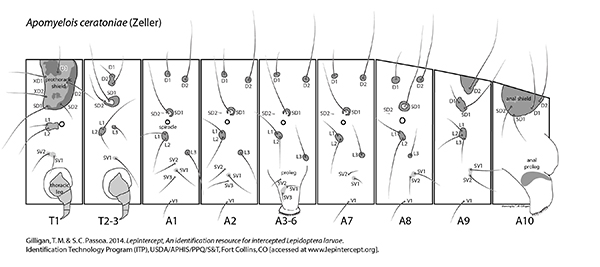 Apomyelois ceratoniae setal map Apomyelois ceratoniae setal map
<< Previous fact sheet Next fact sheet >>
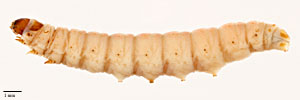 Fig. 1: Late instar, lateral view
Fig. 1: Late instar, lateral view |
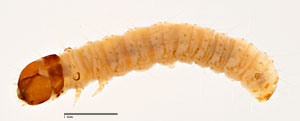 Fig. 2: Early instar, dorsolateral view
Fig. 2: Early instar, dorsolateral view |
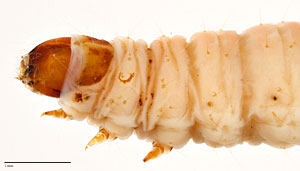 Fig. 3: Head and thorax, lateral view
Fig. 3: Head and thorax, lateral view |
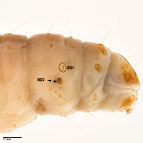 Fig. 4: SD2 is separated from the spiracle of A8 by at least two times the spiracle's diameter
Fig. 4: SD2 on A8 |
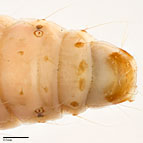 Fig. 5: Anal shield; complete sclerotized ring around SD1 of A8
Fig. 5: Anal shield |

Fig. 6: Crochets |
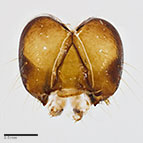 Fig. 7: Head; adfrontal area reaches the epicranial notch (the epicranial suture is absent)
Fig. 7: Head |
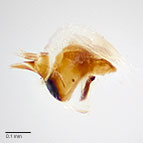 Fig. 8: Hypopharyngeal complex, lateral view
Fig. 8: Hypo. complex |
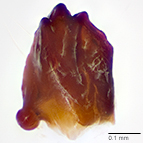
Fig. 9: Mandible |
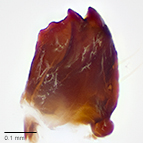
Fig. 10: Mandible |
|
|
|
|
|
|